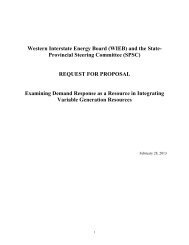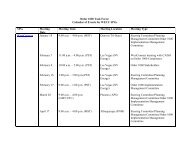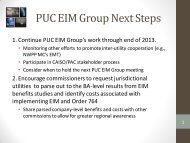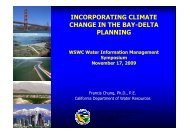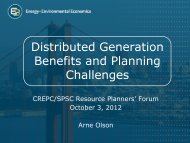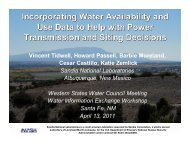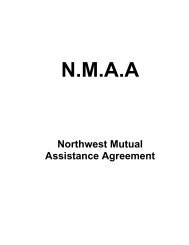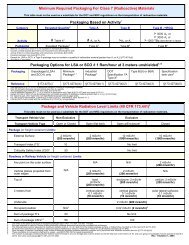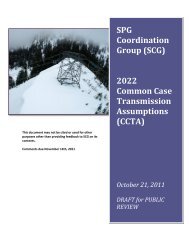WRAT Final Briefing Paper - Western Governors' Association
WRAT Final Briefing Paper - Western Governors' Association
WRAT Final Briefing Paper - Western Governors' Association
Create successful ePaper yourself
Turn your PDF publications into a flip-book with our unique Google optimized e-Paper software.
the interconnection and sub-regions, and making this information transparent and widely<br />
available. This should include information such as expected plant construction, outages,<br />
forecast loads, demand response, power flows, renewable and hydro resource availability, and<br />
potential transmission and fuel supply constraints.<br />
Three key components of information and transparency needed for adequacy are highlighted<br />
below.<br />
• Load Forecasts. The rigorous and transparent assessment of the WI electricity system<br />
must begin with a well-understood, robust, documented transparent set of LSE demand<br />
forecasts. These do not exist or are not documented and readily available. At the<br />
present time, WECC is the only regional entity gathering data from all control areas on<br />
electricity loads and forecasts. The FERC requires all entities serving loads > 200<br />
megawatts to file load information and forecasts annually, but this data is not timely,<br />
has apparent errors and lacks documentation. The forecasts that WECC reports are<br />
summarized at the level of four major WI sub-regions. WECC does not receive<br />
forecasts of individual LSEs unless these also happen to be control areas. Thus, WECC<br />
obtains the same level of detail from the 45,000 MW CAISO as it does from the 600<br />
MW Imperial Irrigation District. There is virtually no supporting explanation provided<br />
to WECC, much less the public, of the forecast assumptions submitted to WECC.<br />
Thus one control area’s forecast may be based on bullish forecasts of economic<br />
activity and population growth while another’s may be very conservative in projecting<br />
these factors. The WECC forecasts also do not provide estimates of loads under<br />
alternative scenarios (e.g. higher than average peak summer temperature conditions,<br />
colder than average winter peak temperature conditions, adverse hydrological<br />
conditions over two or more years).<br />
• Generation Facility Availability. In order to evaluate the ability of the region, subregions<br />
and LSEs to meet load it is necessary to have a reasonably detailed<br />
understanding of the available generation resources and the energy generation<br />
expected from operations. WECC maintains a detailed public data base of existing<br />
generation and potential additions. Beyond this static information, analysts need to<br />
better understand how the generation resources perform under different system<br />
conditions (drought, heat spells, etc.) Data needs also include forced and planned<br />
outages. From an adequacy perspective, it is important to note information is most<br />
needed on a prospective, planning basis, not an historic, after-the-fact basis as<br />
emerging renewable generation tracking mechanisms being developed are designed to<br />
collect.<br />
• Transmission System Constraints and Expansion. A third critical component of the<br />
data needs for adequacy is to have an accurate portrayal of the transmission system,<br />
8<br />
<strong>Final</strong> Consensus Draft<br />
Westwide Resource Assessment Team



